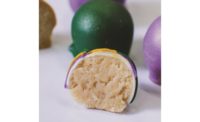Tortilla Trends: clean label and exciting flavors resonate
Health, high quality and culinary flavors lead the trend pack






According to IBISWorld, tortilla production in the U.S. has grown 3 percent in the past five years thanks to the fact that tortillas—especially ones boosted with ingredients like spinach and whole wheat—are perceived to be healthier than bread during a time when consumers value nutrition.
Other reasons for growth include the growing Hispanic population, consumers looking for healthier bread alternatives, and the increased popularity of Mexican foods, says Dan Gooch, vice president of operations, Catallia Mexican Foods LLC, Eagan, MN. As for tortilla chips, he adds, the same drivers apply, but add to this the fact that snacking is at an all-time high.
IRI says sales of tortilla chips rose about 5.85 percent in the 52 weeks ending January 27, 2019 to reach $5.5 billion. Clean label showed strength, with Late July organic tortilla chips growing 63.18 percent to $26.8 million. Also, Frito-Lay’s Organic Doritos brand had a good year, taking in $26.7 million in dollar sales.
Similar trends were seen in hard and soft tortillas and taco kits, growing 4.05 percent in sales to reach about $2.5 billion for the year. Mission Foods saw its Mission Organics brand take in $18.0 million. The company’s better-for-you products notably gained traction, with Mission Carb Balance tortillas growing 26.31 percent to $53.3 million. Also, the Ole Mexican Foods brand Ole Xtreme Wellness—diabetic-friendly products with a low-carb, low-calorie profile—grew 30.45 percent to $46.3 million.
Together, tortilla wraps and chips benefit from the fact that they’re seen as inherently clean label, says Keyla Rodriguez, technical service manager, starches, sweeteners, and texturizers, Cargill, Minneapolis. “The fundamental tortilla chip consists of just four ingredients: corn, vegetable oil, salt and water,” she says. “Recent new product launches have included organic, baked and functionally-enriched chips, all playing to consumer desires for more snack options.”
Top trends
Current trends in the tortilla and tortilla chip markets mirror clean-label trends in other segments. From transparency and better-for-you to organic and non-GMO, consumers are simply demanding more. At RW Garcia, Scotts Valley, CA, this translates to ingredients like vegetable and seed inclusions, and flavoring with organic ingredients, says Genelle Chetcuti, vice president of marketing. “Tortilla chips containing ingredients such as vegetables, legumes, pulse crops and seeds are continuing to resonate with consumers.”
Rodriguez notes that consumers continue to be drawn to tortilla chips made with corn flour, seeking out textures and flavor profiles that can be connected with authentic Mexican chip concepts.” At the same time, she adds, “We’re also seeing innovative tortilla chips made with beans and ancient grains, along with some that use other non-traditional ingredients to increase protein and fiber content.”
In fact, ancient grains are pushing the envelope in this space and, to meet demand, the Whole Harvest brand from Bunge North America, St. Louis, offers a complete portfolio of ingredients like quinoa, sorghum and millet that can all be added to masa products. The reason for these ingredients’ popularity, says Olga Garcia, milling marketing manager, is that they add nutritional value like higher fiber and protein, but are also naturally gluten- and GMO-free.
Alternative flours are also making waves in this market. “By using alternative flours like rice, almond and cassava, the tortilla has a new taste and is attractive to the gluten-free consumer,” says Steve McIver, tortilla specialist, Brolite Products, Bartlett, IL.
Oils also play a large part in the clean-label trend as it pertains to tortilla chips. As Jana Mauck, marketing manager, edible oils, Cargill, explains, the choice of oil can impact both flavor and shelf-life stability. Cargill offers consumer-friendly options like canola, corn, high-oleic canola and non-GMO high-oleic sunflower oil, which are all common solutions for tortilla chips. “New to the Cargill portfolio is Clear Valley non-GMO high-oleic canola oil, which contains 6.5 percent saturated fat and 73 percent oleic levels,” she says. “The high oleic levels translate to higher stability, giving this specialty oil a longer shelf life and better frying stability compared to generic canola oil, while maintaining the desired flavor profile and the added benefit of a label-friendly Non-GMO Project Verified claim.”
As for health trends, keto is making an impact, driving consumers to seek out high-protein options. “I think these trends are consistent with what we’re seeing in health trends in general,” says Gooch, “and tortillas are an easy, versatile way to incorporate those nutrients in to a diet and healthy lifestyle.”
Flavor trends
“Flavor still is, and will remain, an important attribute that will continue to drive the category,” says Garcia. She notes that flavor trends include options inspired by Latin American entrées and sauces. Of course, spicy flavors have been growing in popularity, translating into seasoned tortilla chips and flavored wraps that give snacks a little something extra. “The overall American flavor profile is maturing as Americans are becoming more familiar with ethic flavors and looking for it in foodservice, retail products, and even K-12 schools, colleges, and universities,” says Gooch. “As the American population becomes more diverse, so does the flavor profile.” He sees flavors like chile—and particularly ancho chile—and sea salt and lime as leading the pack.
Tortilla chip brands are also growing beyond spicy to include but innovative flavor combinations. According to Rodriguez, these include unique blends like sriracha, peach-habanero, cinnamon-sugar, kimchi and even seasonal options like pumpkin-cranberry flavored tortilla chips.
The outlook for 2019 and beyond remains positive, since shoppers seeking clean-label, adventurous and high-quality tortillas and tortilla chips all appear to be invested in buying better for the long run, and also paying more for these amped-up offerings.
Looking for a reprint of this article?
From high-res PDFs to custom plaques, order your copy today!









